
Climate change could see more trees in cities to tackle heatwaves
BBC News
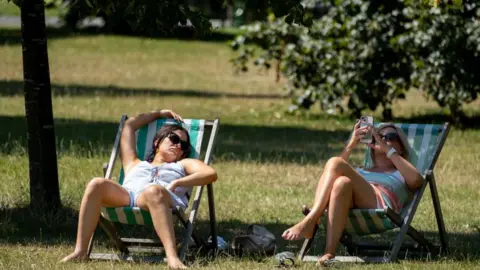 Getty Images
Getty ImagesTree planting in city centres needs to “go harder and go faster” in order to help keep them cool ahead of future deadly heatwaves, an expert has said.
Scientists working on the problem have said planting more trees could cut air temperatures by up to 5C (9F).
Breezeways – outdoor passages with roofs that improve airflow – water features and curved buildings could also tackle the issue, but planting more trees should be the priority, said the team from Cardiff University.
Temperature reductions from tree coverage were “significant”, according to Prof Philip Jones from the Welsh School of Architecture, who led a collaboration with researchers from Hong Kong.
The UK Climate Change Committee previously reported that heat-related deaths could rise from 3,000 in 2022 to more than 10,000 in an average year by 2050.
The team from Cardiff University previously modelled how rising temperatures could affect people in the cities of Cardiff, Newport and Wrexham.
Our bodies strive to keep a core temperature of about 37C (98F) but in hot weather, the body must work harder to keep its core temperature down, which can lead to potentially fatal heat exhaustion.
The team’s latest research measured the success of green interventions and results suggest that planting trees could make a tangible difference.
Prof Jones said in order to cool an area by 4-5C (7.2-9F) “we’ve got to increase the tree coverage to somewhere in the order of 30-40%”.
The team’s computer model was designed in collaboration with researchers from the Tsinghua University Shenzhen International School and, to verify the data, the team took a specially adapted bike around Cardiff during a hot spell to measure the differences in temperature between shaded and exposed areas.
They focused on Grangetown, where there has already been efforts to plant more and where the maximum tree cover has the potential to be 38%.
That is “significantly higher than typical interventions”, according to Prof Jones, but reaching that level could reduce average air temperatures by between 1.4C and 4C
How trees could change the temperature of one residential street
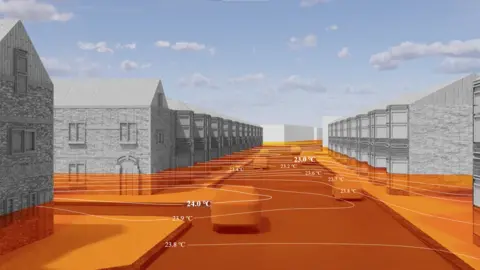 Cardiff University/Tsinghua University Shenzhen International School
Cardiff University/Tsinghua University Shenzhen International School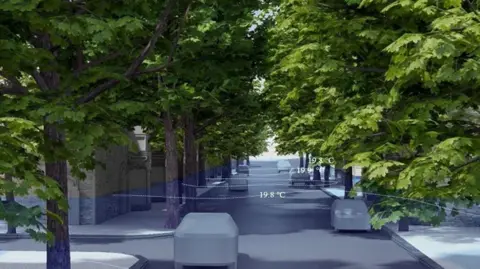 Cardiff University/Tsinghua University Shenzhen International School
Cardiff University/Tsinghua University Shenzhen International SchoolIn 2020, Natural Resources Wales (NRW) found Cardiff had 15.1% canopy cover, Bangor had 18.6%, Wrexham had 14%, Swansea and Newport both had 18.4%
There are ambitions in Newport to raise its tree cover to 25% but that requires an extra 30,000 trees and is expected to take 10 years.
Peter Frost, an urban green infrastructure advisor for NRW, said the planting of large tree species should start immediately.
He said Wales’ legislation meant “every new building that requires planning permission has to be drained naturally”.
Water companies were also considering this, he said, as they “can no longer fit the amount of rainwater that’s going into the combined sewers”.
He added: “So it has to have a system where we’re using natural methods to deal with the rainfall and that gives us a massive opportunity to put trees in.
“So they’re thinking about retrofitting sustainable drainage systems into our streets. And there’s a great opportunity there to put trees in. But we need to go faster and we need to go harder at this.”
He said if urban areas could get to the upper end of what was achievable with tree planting, then there could be significant effects.
Having tree canopy of 40% or above means less space between trees so pavements and walls do not heat up as much as they are in shade and it would keep cities cooler overnight too.
“And that’s when we see most people dying of heat stress during heatwaves when they can’t cool down overnight,” he said.
Mr Frost said trees brought further advantages during winter when there was less daylight as leaves fall off deciduous trees so “that low, angled winter sun can make its way into buildings and warm you up, and then you don’t have to spend quite so much on heating”.
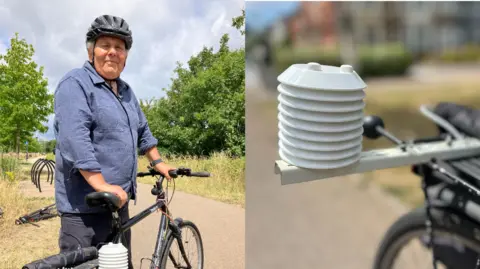
Met Office modelling estimates that temperatures higher than 40C in the UK may be considered cool by the turn of the century.
People living in cities are more at risk from heatwaves than those in rural areas due to the urban heat island effect when heat is trapped by tall buildings, absorbed by tarmac and concrete and released by heating and air conditioning.
Green spaces moderate temperature through shading and by increasing the amount of water that passes into the air through a process called evapotranspiration, but there tends to be fewer shaded spaces in urban areas.
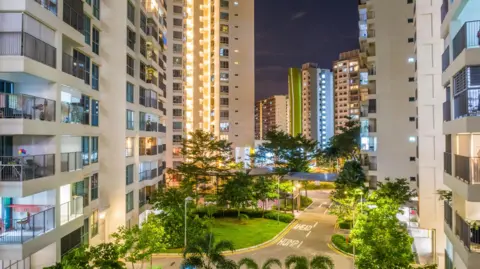 Getty Images
Getty ImagesProf Jones has looked at measures to mitigate the effects of heat in places such as Hong Kong, Singapore and Miami.
In Singapore, where temperatures in the city centre can be a 7C (12.6F) hotter than outside it, authorities are incorporating open spaces around buildings and lighter colours on walls and roofs, as well as increasing the amount of greenery in the city.
Nearly half of Singapore is now green space and more than 500,000 trees have been planted since 2020 – with a target of one million by 2030.
Varying building heights and even making the corners of buildings curved are all effective ways to reduce temperatures without the need for air conditioning.
But as trees are inexpensive and take time to reach full maturity, Prof Jones said UK cities should start planting as many as possible now.
The Welsh government said: “Trees on streets and in parks play a vital role in helping us adapt to the effects of a changing climate and in supporting wildlife in urban areas.
“Our Woodlands for Wales strategy explains how we want trees to be used more creatively in green infrastructure and around urban areas to provide people with better quality, easily accessible green space.”


